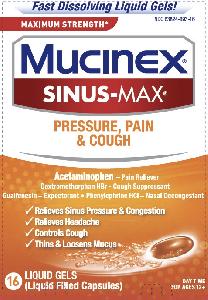Mucinex Sinus-Max Pressure, Pain & Cough Interactions
There are 621 drugs known to interact with Mucinex Sinus-Max Pressure, Pain & Cough (acetaminophen / dextromethorphan / guaifenesin / phenylephrine), along with 7 disease interactions, and 1 alcohol/food interaction. Of the total drug interactions, 95 are major, 509 are moderate, and 17 are minor.
- View all 621 medications that may interact with Mucinex Sinus-Max Pressure, Pain & Cough
- View Mucinex Sinus-Max Pressure, Pain & Cough alcohol/food interactions (1)
- View Mucinex Sinus-Max Pressure, Pain & Cough disease interactions (7)
Most frequently checked interactions
View interaction reports for Mucinex Sinus-Max Pressure, Pain & Cough (acetaminophen / dextromethorphan / guaifenesin / phenylephrine) and the medicines listed below.
- acetaminophen
- alprazolam
- amitriptyline
- amoxicillin
- aspirin
- azithromycin
- Benadryl (diphenhydramine)
- buspirone
- Claritin (loratadine)
- doxycycline
- famotidine
- gabapentin
- hydrochlorothiazide
- hydroxyzine
- ibuprofen
- lorazepam
- melatonin
- meloxicam
- metformin
- MiraLAX (polyethylene glycol 3350)
- naproxen
- omeprazole
- ondansetron
- prednisone
- tizanidine
- trazodone
- Tylenol (acetaminophen)
- valacyclovir
- Vitamin D3 (cholecalciferol)
- Zyrtec (cetirizine)
Mucinex Sinus-Max Pressure, Pain & Cough alcohol/food interactions
There is 1 alcohol/food interaction with Mucinex Sinus-Max Pressure, Pain & Cough (acetaminophen / dextromethorphan / guaifenesin / phenylephrine).
Mucinex Sinus-Max Pressure, Pain & Cough disease interactions
There are 7 disease interactions with Mucinex Sinus-Max Pressure, Pain & Cough (acetaminophen / dextromethorphan / guaifenesin / phenylephrine) which include:
More about Mucinex Sinus-Max Pressure, Pain & Cough (acetaminophen / dextromethorphan / guaifenesin / phenylephrine)
- Compare alternatives
- Drug images
- Side effects
- Dosage information
- During pregnancy
- Drug class: upper respiratory combinations
Related treatment guides
Drug Interaction Classification
| Highly clinically significant. Avoid combinations; the risk of the interaction outweighs the benefit. | |
| Moderately clinically significant. Usually avoid combinations; use it only under special circumstances. | |
| Minimally clinically significant. Minimize risk; assess risk and consider an alternative drug, take steps to circumvent the interaction risk and/or institute a monitoring plan. | |
| No interaction information available. |
Further information
Always consult your healthcare provider to ensure the information displayed on this page applies to your personal circumstances.


